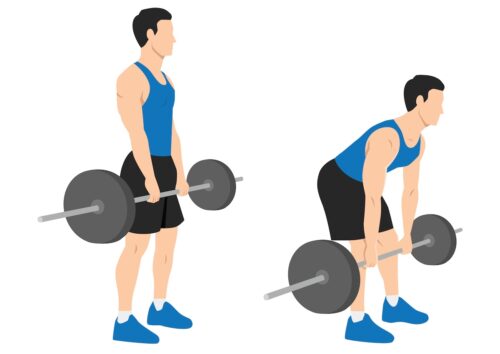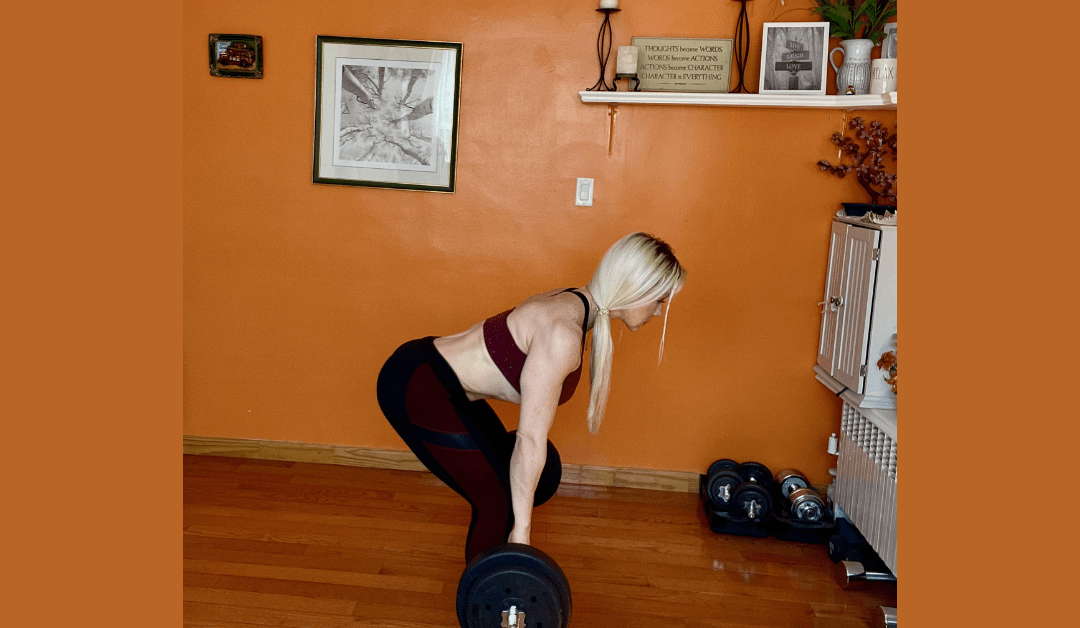Do you want nice-looking legs and glutes? The Romanian deadlift (RDL) is another great exercise for the muscles in the posterior chain. The RDL involves hip flexion during the lowering phase, as well as back and hip extension when returning the body to an upright position.
What Muscles Do Romanian Deadlifts Work?
The Romanian deadlift is a compound exercise that works numerous muscles.
- Hamstrings: Located on the posterior thigh in between the hip and the knee, and are composed of three muscle groups (semitendinosus, semimembranosus, and biceps femoris – long and short heads). These muscles are antagonists to the quadriceps and are involved in hip and knee movements. They participate in the deceleration of knee extension and help flex the knee and extend the hips. They are essential for daily movement (walking), speed (running), and deceleration (stopping movement).
- Gluteal Muscles (buttocks): These muscles are involved in the extension, abduction, and rotation of the hip joint. They also help keep the body erect and assist human locomotion (running, jumping, sprinting, etc).
- Erector Spinae (lower back): Set of muscles that run vertically along the side of the vertebral column, originating at the hip and extending up to the skull. These muscles help rotate and extend the spine and neck.
- Adductor Magnus: Large triangular muscles, situated on the inside of the thighs. They adduct the legs, moving them toward each other, rotate the leg inwards, and extend the hips.
- Upper Back Muscles: Trapezius (large paired muscles that extend longitudinally from the posterior top of the neck to the middle of the back and laterally from one end of the scapula to the other end). They support the arm and retract, rotate, and depress the scapula. In the movement, they keep the torso and shoulder from rounding forwards in the lift. Rhomboids (muscles that go on top of the scapula on each side of the upper back). They move and support the scapula. In the RDL, they maintain a flat back, resist spinal flexion and rounding of the shoulders.
- Forearms: Located in the upper limbs between the elbows and the wrists. They help hold the weight.
- Gastrocnemius: Superficial two-headed muscles that are in the back part of the lower leg, forming the calves. They flex the foot at the ankle joint and the leg at the knee joint. They are involved in fast movements such as running and jumping.
Romanian Deadlifts’ Benefits
- Fat Loss: Being that the RDL is a compound exercise that engages multiple joints and muscle groups simultaneously, it helps you to burn more calories and, subsequently, more fat.
- Aesthetics: Romanian Deadlifts help sculpt a rounded booty, shapely legs, and a beautiful lower back.
- Hypertrophy: Romanian deadlifts allow you to move a significant amount of weight to help build mass in your glutes, hamstrings, and lower back. You can gain mass by using a challenging weight for 8-12 reps, doing numerous sets, moving the weight slowly to maintain your muscles under tension for longer periods, and/or rest for shorter periods using high volume.
- Strength: Building muscle in your posterior chain allows you to get stronger and lift heavier, not only through other types of deadlifts but during squats, rows, hamstring curls, snatches, and cleans as well. You can increase your strength by using high volumes for 3, 5, or 8 reps.
- Endurance & Performance: This compound exercise can also translate into improved athletic performance and less muscle fatigue. You can increase muscular endurance by using lighter loads for 12-20 reps and 2-4 sets.
- Grip & Forearm Strength: Deadlifts help to strengthen your forearms and grip as you have to hold the hanging weight for long periods. This is helpful during other exercises such as rows, pull-ups, snatches, and cleans.
- Flexibility & Mobility: Romanian deadlifts involve a big movement that helps increase your hip’s range of motion and make you more mobile.
- Core Strength: This movement tightens and strengthens your core (your lower back, abs, diaphragm, obliques, and pelvic floor muscles).
- Back Health: Romanian deadlifts strengthen your back and core, helping keep your back healthy which prevents injuries and back pain.
- Proper Biomechanics: The RDL involves proper hip flexion and extension. It requires a hip hinge position that moves the pelvis posteriorly and teaches how to lift from the hips instead of the lower back. This is essential for proper squatting or just for bending over to pick up objects. Proper biomechanics can reduce your risk of injury that happens when lifting heavy things in an improper manner.
- Efficiency: Romanian deadlifts are highly efficient as you work numerous muscles simultaneously. Plus, all you need is a barbell or a set of dumbbells.
How to Do Romanian Deadlifts

If you are a beginner, you should perfect the movement with a PVC bar or stick before using weights. You can add resistance by using a medicine ball or you can do the Romanian Deadlift with Dumbbells. Later on, you can use a barbell.
- Stand with your chest lifted, back straight, shoulders back, core tight, and chin slightly tucked into the neck.
- Grasp a barbell using a pronated (palms-down) grip with your hands shoulder-width apart. Stand with your feet hip-width apart and knees slightly bent. Allow the bar to rest along the front of your thighs.
- Push your butt back and hinge forward from your hips. Allow the weight to lower toward the floor while maintaining length through the spine.
- Don’t round your back or extend the knees while lowering the weight.
- Lean over until your back is roughly parallel to the floor until tension is felt in the hamstrings. The bar should be about knee height or about mid-shin if you are flexible.
- Proceed to push both heels onto the floor, press your hips forward, pull back on the knees, and bring your torso back up. Allow the barbell to return to the front of the thighs.
- Keep the back straight and a slight bend in the knees throughout the movement. The barbell is kept closer to the body during the movement.
- Repeat.
Romanian Deadlifts Mistakes
- Avoid rounding your upper back and shoulders. Keep your chest open and shoulders back to help maintain your back straight.
- Avoid bending the spine. Rounding the back instead of hinging from the hips can hurt the lower back.
- Avoid bending your knees. You bend the knees to do squats, not RDLs. But even if you are doing squats, you don’t let the knees move forward, you push back into the hips.
- Avoid locking your knees. Your knees are almost completely straight when doing the stiff-legged deadlift, not the RDL. The knees are slightly bent during RDLs to provide greater hip activation and flexion.
- Avoid looking up or watching yourself in the mirror when performing the lift. Looking up or to the sides during the RDL strains your back and/or neck. Keep your neck in a neutral position and look toward the floor while hinging forward at the hips.
Barbell Romanian Deadlift Video
Leg Workout
You can complete your lower body workout with Squats, Front Lunges, Side Lunges, Reverse Glute Raises, Squat Jumps, Deadlifts, and Reverse Lunges.
Lift, Burn More Fat, Get Stronger and Live Healthier!
To a Fitter Healthier You,
The Fitness Wellness Mentor



